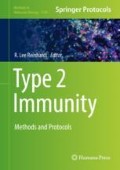Abstract
Helminth parasites infect over 2 billion people worldwide resulting in huge global health and economic burden. Helminths typically stimulate Type 2 immune responses and excel at manipulating or suppressing host-immune responses resulting in chronic infections that can last for years to decades. Alongside the importance for the development of helminth treatments and vaccines, studying helminth immunity has unraveled many fundamental aspects of Type 2 immunity and immune regulation with implications for the treatment of autoimmunity and Type 2-mediated diseases, such as allergies. Here we describe the maintenance and use of Litomosoides sigmodontis, a murine model for studying host-parasite interactions, Type 2 immunity, and vaccines to tissue-dwelling filarial nematodes, which in humans cause lymphatic filariasis (e.g., Brugia malayi) and onchocerciasis (Onchocerca volvulus).
Access this chapter
Tax calculation will be finalised at checkout
Purchases are for personal use only
References
Hoffmann W, Petit G, Schulz-Key H, Taylor D, Bain O, Le Goff L (2000) Litomosoides sigmodontis in mice: reappraisal of an old model for filarial research. Parasitol Today 16:387–389
Le Goff L, Lamb TJ, Graham AL, Harcus Y, Allen JE (2002) IL-4 is required to prevent filarial nematode development in resistant but not susceptible strains of mice. Int J Parasitol 32:1277–1284
Volkmann L, Bain O, Saeftel M, Specht S, Fischer K, Brombacher F, Matthaei KI, Hoerauf A (2003) Murine filariasis: interleukin 4 and interleukin 5 lead to containment of different worm developmental stages. Med Microbiol Immunol 192:23–31
Petit G, Diagne M, Marechal P, Owen D, Taylor D, Bain O (1992) Maturation of the filaria Litomosoides sigmodontis in BALB/c mice; comparative susceptibility of nine other inbred strains. Ann Parasitol Hum Comp 67:144–150
Marechal P, Le Goff L, Petit G, Diagne M, Taylor DW, Bain O (1996) The fate of the filaria Litomosoides sigmodontis in susceptible and naturally resistant mice. Parasite 3:25–31
Al-Qaoud KM, Taubert A, Zahner H, Fleischer B, Hoerauf A (1997) Infection of BALB/c mice with the filarial nematode Litomosoides sigmodontis: role of CD4+ T cells in controlling larval development. Infect Immun 65(6):2457–2461
Hubner MP, Torrero MN, McCall JW, Mitre E (2009) Litomosoides sigmodontis: a simple method to infect mice with L3 larvae obtained from the pleural space of recently infected jirds (Meriones unguiculatus). Exp Parasitol 123:95–98
Babayan S, Attout T, Specht S, Hoerauf A, Snounou G, Renia L, Korenaga M, Bain O, Martin C (2005) Increased early local immune responses and altered worm development in high-dose infections of mice susceptible to the filaria Litomosoides sigmodontis. Med Microbiol Immunol 194:151–162
Graham AL, Taylor MD, Le Goff L, Lamb TJ, Magennis M, Allen JE (2005) Quantitative appraisal of murine filariasis confirms host strain differences but reveals that BALB/c females are more susceptible than males to Litomosoides sigmodontis. Microbes Infect 7:612–618
Acknowledgments
Many thanks to Brian Chan for proofreading. The protocols in this paper were developed during research funded by the MRC UK, Wellcome Trust, and European Union.
Author information
Authors and Affiliations
Corresponding author
Editor information
Editors and Affiliations
Rights and permissions
Copyright information
© 2018 Springer Science+Business Media, LLC, part of Springer Nature
About this protocol
Cite this protocol
Fulton, A., Babayan, S.A., Taylor, M.D. (2018). Use of the Litomosoides sigmodontis Infection Model of Filariasis to Study Type 2 Immunity. In: Reinhardt, R. (eds) Type 2 Immunity. Methods in Molecular Biology, vol 1799. Humana, New York, NY. https://doi.org/10.1007/978-1-4939-7896-0_2
Download citation
DOI: https://doi.org/10.1007/978-1-4939-7896-0_2
Published:
Publisher Name: Humana, New York, NY
Print ISBN: 978-1-4939-7895-3
Online ISBN: 978-1-4939-7896-0
eBook Packages: Springer Protocols

